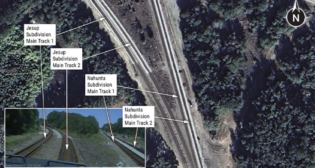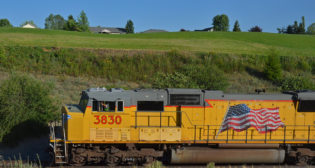
Metro-North wreck kills four, injures 63
Written by William C. Vantuono, Editor-in-Chief The wreck occurred at Spuyten Duyvil interlocking, where Metro-North’s Hudson Line meets Amtrak’s West Side Line (the “Empire Connection”). Preliminary reports say the train was traveling at 82 mph when it entered the curve, which has a speed limit of 30 mph. The curve, according to New York MTA officials, is the sharpest on Metro-North’s system. The speed limit on the tangent section of track leading up to the curve is 70 mph.
The wreck occurred at Spuyten Duyvil interlocking, where Metro-North’s Hudson Line meets Amtrak’s West Side Line (the “Empire Connection”). Preliminary reports say the train was traveling at 82 mph when it entered the curve, which has a speed limit of 30 mph. The curve, according to New York MTA officials, is the sharpest on Metro-North’s system. The speed limit on the tangent section of track leading up to the curve is 70 mph.
On the day of the wreck, an MTA official said the train’s engineer, William Rockefeller Jr., who has 20 years’ experience with the railroad, 11 as an engineer, told first responders that the train’s service brakes failed, and when he realized the train was heading into the curve too quickly, he made an emergency brake application. Reports as of Tuesday, Dec. 3, suggest otherwise. The National Transportation Safety Board and Federal Railroad Administration are investigating the cause of the wreck and have examined the locomotive and cab car event recorders. An NTSB official said that, according to preliminary information taken from an event recorders, the throttle was fully engaged until six seconds before the locomotive came to a stop on its side, and the brakes were fully applied only five seconds before that. Also, the train’s braking system and the signal system at this point in the investigation have been determined to have been functioning normally.
Rockefeller has told investigators that he had experienced a hypnotic-like “daze” before realizing something was wrong and applying the emergency brakes, his attorney said. Attorney Jeffrey Chartier accompanied Rockefeller to his interview with NTSB investigators Tuesday and described the account Rockefeller gave. Chartier said the engineer experienced a nod or “a daze” similar to road fatigue or the phenomenon sometimes called “highway hypnosis.” What Rockefeller remembers is “operating the train, coming to a section where the track was still clear—then, all of a sudden, feeling something was wrong and hitting the brakes,” Chartier said.
Anthony Bottalico, who heads Metro-North’s union, the Association of Commuter Rail Employees, said Tuesday that Rockefeller “basically nodded” just before the wreck. “There was a lapse and that was a nod or however they want to couch it,” said Bottalico. “And it was a mistake that any of us could make, and he caught that mistake too late.”
A final NTSB report will take about a year to be issued.
Rockefeller, 46, was among those injured. Three of the four dead were thrown from the train after the windows blew out, officials said. There were also three conductors on board the train, which was carrying a light passenger load of about 150 people, far less than during a weekday peak period.
The section of Metro-North right-of-way where the accident occurred is equipped with a cab signal system that, while enforcing train separation with a penalty brake application if the engineer does not respond to the speed indication, does not enforce civil speed restrictions on curves. At this particular location, there is a drastic reduction in track speed, from 70 mph to 30 mph. Though Rockefeller made an emergency brake application (“dumped the air”), it was too late to reduce the train’s speed to where it could have negotiated the curve without derailing. Also, the train’s cab car, though equipped with a “deadman’s pedal,” was not equipped with an alerter system that Rockefeller would have had to acknowledge on a regular basis (approximately every 30 to 45 seconds).
Amtrak Empire Corridor service between Penn Station New York and Albany resumed mid-afternoon Sunday.
The accident, the first one in Metro-North’s 30-year history involving passenger fatalities, occurred during a particularly troubled year for Metro-North, the nation’s second-largest commuter railroad. In May, a broken rail caused a Metro-North M8 electric multiple-unit train to derail and sideswipe another M8 consist traveling in the opposite direction on the New Haven Line (Northeast Corridor) in Fairfield, Conn., injuring about 60, five critically.
In July, a CSX freight train derailed near where the Metro-North train left the tracks on Sunday. Officials said there was no connection between the accidents.
In September, a power failure in Mount Vernon, N.Y., disrupted service on the New Haven Line, leading the MTA to offer credits to affected riders.
These incidents have occurred during a period of retirements that have left several positions either vacant or filled by less-experienced employees. Retirements of high-level employees have become increasingly frequent, MTA officials said, because under recently revised Railroad Retirement provisions, retirees can receive full pensions after 30 years of service.
By Sunday night, the NTSB had given Metro-North clearance to begin removing the derailed equipment and repairing the tracks. The crash disrupted the Monday commute for thousands of passengers on the railroad’s Hudson Line. Trains ran as far south as Yonkers, N.Y., where passengers were transferred to buses that took them to the 242nd Street Station of New York City Transit’s No. 1 subway line.
Just recently, the MTA awarded a contract to a consortium of Bombardier Transportation Rail Control Solutions and Siemens Rail Automation for an overlay vital PTC system on both Metro-North and the Long Island Rail Road. Such a system would presumably have prevented this most recent wreck, though other sources Railway Age spoke with for this article said that the relatively simple civil speed enforcement feature that currently is not present in Metro-North’s existing cab signal equipment—but employed by Amtrak on the Northeast Corridor—could very well have provided the same safety benefits as PTC.



